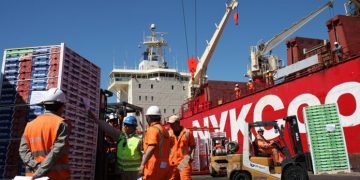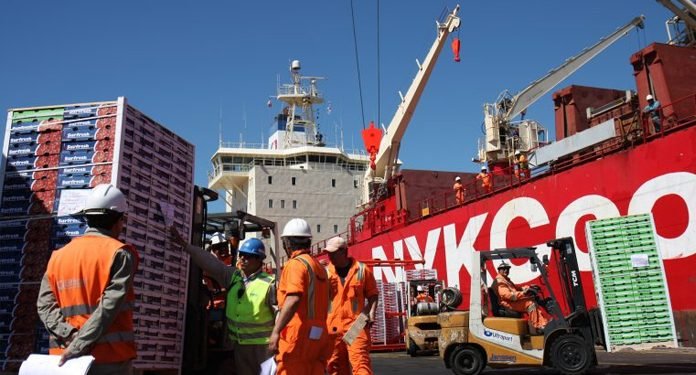By Maria Kalamatas | July 18, 2025
San Antonio, July 18 — For the first time in Chile’s history, exporters now have access to a direct shipping lane to Asia, thanks to a new weekly service launched from the port of San Antonio. The route eliminates stopovers in Panama and North America, reducing delivery times to Asian markets by up to eight days.
“This is more than just a new connection — it’s a strategic turning point for our entire export economy,” said Cristian Herrera, general manager of DP World Chile. “It positions San Antonio as the most efficient Pacific gateway for South America.”
From farm to market — faster
The inaugural vessel, CMA CGM Legacy, departed San Antonio on July 17 carrying a mixed load of fresh fruit, frozen seafood, wine, and lumber. Its destination: the ports of Busan, Ningbo, and Hong Kong, without a single transshipment stop.
For agricultural exporters, this direct path couldn’t come soon enough. The delay caused by routing cargo through Central America or the U.S. West Coast has long posed a challenge for sensitive goods like cherries, grapes, and salmon.
“In our business, freshness has a narrow window,” said Gabriela Yáñez, head of exports at AndesFresh. “This new route lets us get produce into Chinese retail shelves within 21 days of harvest — that’s a major breakthrough.”
Terminal upgrades support the shift
To prepare for the new service, DP World San Antonio upgraded its reefer infrastructure, expanded yard space, and implemented faster customs procedures for perishables. According to port officials, more than 70% of Chile’s refrigerated exports now pass through San Antonio.
“This wasn’t just a matter of adding a ship,” Herrera noted. “We invested heavily to ensure reliability and speed, from loading to departure.”
Beyond Chile: regional opportunities
The success of the direct Chile–Asia lane is already drawing attention from neighboring countries. Logistics firms in Peru and Ecuador are reportedly negotiating feeder routes to tap into San Antonio’s faster connection, bypassing congestion at Panama’s canal and Mexican ports.
“It’s the first time South American exporters are setting the tempo for Pacific trade,” said Felipe Cruz, a shipping analyst based in Valparaíso. “And it’s likely just the beginning.”























